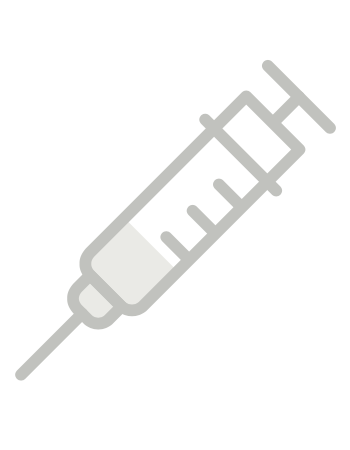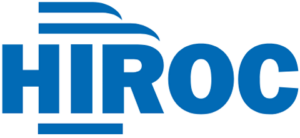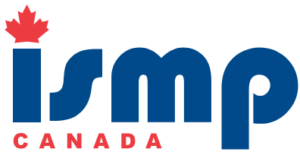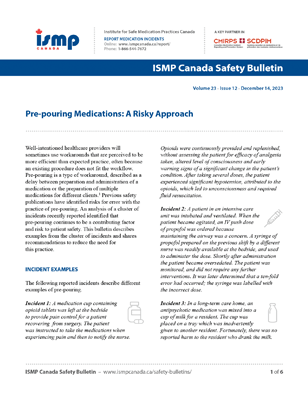Introduction
Well-intentioned healthcare providers will sometimes use workarounds that are perceived to be more efficient than expected practice, often because an existing procedure does not fit the workflow. Pre-pouring is a type of workaround, described as a delay between preparation and administration of a medication or the preparation of multiple medications for different clients.1 Previous safety publications have identified risks for error with the practice of pre-pouring. An analysis of a cluster of incidents recently reported identified that pre-pouring continues to be a contributing factor and risk to patient safety. This bulletin describes examples from the cluster of incidents and shares recommendations to reduce the need for this practice.
Incident Examples
The following reported incidents describe different examples of pre-pouring.

Incident 1: A medication cup containing opioid tablets was left at the bedside to provide pain control for a patient recovering from surgery. The patient was instructed to take the medications when experiencing pain and then to notify the nurse.
Opioids were continuously provided and replenished, without assessing the patient for efficacy of analgesia taken, altered level of consciousness and early warning signs of a significant change in the patient’s condition. After taking several doses, the patient experienced significant hypotension, attributed to the opioids, which led to unconsciousness and required fluid resuscitation.

Incident 2: A patient in an intensive care unit was intubated and ventilated. When the patient became agitated, an IV push dose of propofol was ordered because maintaining the airway was a concern. A syringe of propofol prepared on the previous shift by a different nurse was readily available at the bedside, and used to administer the dose. Shortly after administration the patient became oversedated. The patient was monitored, and did not require any further interventions. It was later determined that a ten-fold error had occurred; the syringe was labelled with the incorrect dose.

Incident 3: In a long-term care home, an antipsychotic medication was mixed into a cup of milk for a resident. The cup was placed on a tray which was inadvertently given to another resident. Fortunately, there was no reported harm to the resident who drank the milk.
Discussion
Several Canadian provincial nursing regulatory bodies, in their medication administration standards, make specific mention of pre-pouring as a practice to be avoided.1-7 Most provincial regulatory authorities expect their members to prepare medications just prior to the time of intended administration.
Box 1 describes reasons to avoid pre-pouring medications.
BOX 1. Reasons to Avoid Pre-pouring Medications.
Pre-pouring is a behaviour that puts patients at risk and is not recommended for the following reasons:
- often involves removal of the medication from packaging that identifies the medication and/or the intended recipient
- often prevents confirmation of the medication/dose to be administered against the medication administration record (MAR) just before the patient receives the medication
- adds risk when pre-poured medications are available at the bedside for self-administration without a clear protocol
- may lead to delayed and/or inaccurate documentation
- clouds accountability for safe medication administration between the nurse preparing the medication and the one administering it to the patient5
- creates possible added risk for contamination (e.g., with pre-drawn syringes)
- enables diversion in some care settings
Recommendations
Healthcare Organizations
- Develop or review a policy that describes acceptable situations in which more than one nurse is involved in the preparation and administration of a medication: for example, in the event of a cardiac arrest.5
- Consider regular pre-pouring of medications as an opportunity to identify the underlying issues leading to this workaround. A proactive approach, such as a cognitive walkthrough,8 can help to identify risks and assess solutions to improve medication administration.
Nurses
- At the end of a nursing shift, dispose of any medications that have been prepared in a syringe. Additionally, at the beginning of a nursing shift, any medications that have been prepared on a previous shift should be discarded.
- Prepare medications just prior to administration, to support a check against the original product and MAR, patient identification and timely documentation.
- Prepare and administer medications for one patient at a time to minimize the risk of wrong patient errors.
- For emergency situations when more than one nurse is involved in the preparation and administration of a medication, one nurse prepares and labels the medication while the other nurse administers it after an independent double check. Some regulatory nursing bodies require both nurses to document in the patient’s health care record.5
Conclusion
The recent analysis of a cluster of incidents has identified the continued practice of pre-pouring medications. Workarounds, such as pre-pouring, can contribute to harmful incidents and they leave system-based problems unsolved.9,10 In order to support safe medication practices, health care teams are encouraged to identify at-risk behaviours such as pre-pouring and collaboratively develop and evaluate system solutions for added safety.11
Sponsors
![]()
The Canadian Medication Incident Reporting and Prevention System (CMIRPS) is a collaborative pan-Canadian program of Health Canada, the Canadian Institute for Health Information (CIHI), the Institute for Safe Medication Practices Canada (ISMP Canada) and Healthcare Excellence Canada (HEC). The goal of CMIRPS is to reduce and prevent harmful medication incidents in Canada.
Funding support provided by Health Canada. The views expressed herein do not necessarily represent the views of Health Canada.

The Healthcare Insurance Reciprocal of Canada (HIROC) provides support for the bulletin and is a member owned expert provider of professional and general liability coverage and risk management support.

The Institute for Safe Medication Practices Canada (ISMP Canada) is an independent national not-for-profit organization committed to the advancement of medication safety in all healthcare settings. ISMP Canada’s mandate includes analyzing medication incidents, making recommendations for the prevention of harmful medication incidents, and facilitating quality improvement initiatives.
Report Medication Incidents (Including near misses)
Online: ismpcanada.ca/report/
Phone: 1-866-544-7672
ISMP Canada strives to ensure confidentiality and security of information received, and respects the wishes of the reporter as to the level of detail to be included in publications.
Stay Informed
To receive ISMP Canada Safety Bulletins and Newsletters visit: https://ismpcanada.ca/safety-bulletins/#footer
This bulletin shares information about safe medication practices, is noncommercial, and is therefore exempt from Canadian anti-spam legislation.
Contact Us
Email: cmirps@ismpcanada.ca
Phone: 1-866-544-7672
©2024 Institute for Safe Medication Practices Canada.
